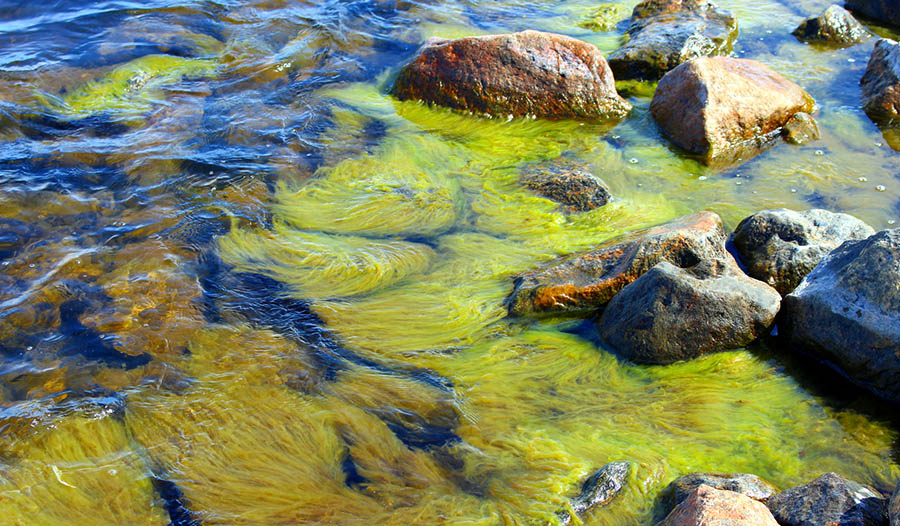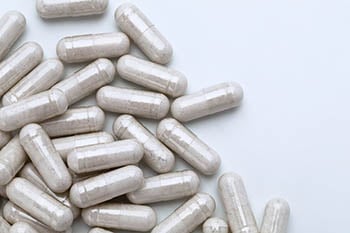The Unique Health Benefits of Astaxanthin
DISCLAIMER:This blog does not intend to provide diagnosis...
- In this article:
- Where Does Astaxanthin Come From?
- How Is Astaxanthin Produced?
- What Makes Astaxanthin Unique?
- Benefits of Astaxanthin
- Research on the Health Benefits of Astaxanthin
- What Is the Dosage of Astaxanthin?
- What Are the Side Effects and Drug Interactions of Astaxanthin?

Updated July 2022 / Originally Posted 2017
Astaxanthin is a vibrantly deep red carotenoid pigment found predominantly in marine life. There are over 400 different members of the carotenoid family of pigments in nature. Historically, the potency of a carotenoid in improving human health was based on its ability to be converted to vitamin A. For example, the pigment that makes carrots orange, beta-carotene, has the highest vitamin A value and was long thought of as the most important carotenoid. However, it is now known that some of the most important carotenoids to human health are not converted to vitamin A at all.
Of all the non-vitamin A carotenoids, astaxanthin is regarded as the “crowned king.” It is given this title because of its unique benefits and actions in promoting health and protecting against cellular damage, especially in the brain and vascular system.
Where Does Astaxanthin Come From?
The richest concentration of astaxanthin is found in a microalgae known as Haematococcus pluvialis. When the algae is consumed by salmon, lobster, shrimp, krill, and other sea life, the intense red pigmentation results in these animals having red or pink flesh or outer shells.
Astaxanthin is essential to the survival of these organisms. For example, astaxanthin is required by the microalgae itself to protect against the damage produced during photosynthesis – the conversion of sunlight into chemical energy. It is also known that young salmon die or do not develop properly without sufficient intake of astaxanthin in their diet. The astaxanthin also provides some protection for some animals by making them less visible in deep water, where the red segment of the wavelength spectrum of visible light does not penetrate. The red pigment also plays a role in mating and spawning behavior.
How Is Astaxanthin Produced?
Although astaxanthin is found in salmon, herring roe, or krill oil supplements, the amounts in these sources are much lower than those provided from extracts of H. pluvialis. For example, the level of astaxanthin naturally occurring in a capsule of fish or krill oil is in the range of 100 mcg (0.1 mg). That amount is not much compared to the 4 to 12 mg per capsule found in most astaxanthin supplements derived from H. pluvialis.
To produce natural astaxanthin, large indoor tanks or outdoor glass-tube plantations are to grow H. pluvialis under ideal conditions that enhance astaxanthin production. These measures also prevent environmental contamination. After the H. pluvialis has produced astaxanthin, extraction methods are used to release the astaxanthin from the thick cell wall of the algae and concentrated.
There are other sources of astaxanthin on the market, but these forms are produced from either chemical synthesis or produced from genetically modified yeast (Xanthophyllomyces dendrorhous, formerly Phaffia rhodozyma). These synthetic forms are approved as feed additives and are often fed to salmon in fish farms to give them red flesh, but the synthetic forms differ in structure from natural astaxanthin. The synthetic form is 20 times less effective as an antioxidant, so it is unlikely it has the same benefits as natural astaxanthin.1
What Makes Astaxanthin Unique?
It is a bit cliché to refer to various natural compounds as antioxidants. Yes, astaxanthin has antioxidant activity, and it helps to prevent the oxidative damage that contributes to conditions such as aging, insulin resistance, cardiovascular disease, and neurodegenerative conditions such as Alzheimer’s disease. And yes, so do many other natural antioxidants. But astaxanthin is a bit different from an antioxidant and exerts additional benefits to protect cells.2
First, regarding general antioxidant actions in protecting cell membranes, astaxanthin exerts significantly stronger effects than many popular antioxidants.
As a protector against oxidative damage, astaxanthin is:
- 6000 times more effective than vitamin C
- 800 times more effective than CoQ10
- 550 times more effective than green tea polyphenols
- 500 times more effective than vitamin E
- 75 times more effective than alpha-lipoic acid
- 11 times more effective than beta-carotene
In free radical elimination, astaxanthin is:
- 65 times more effective than vitamin C
- 54 times more effective than beta-carotene
- 21 times more effective than synthetic astaxanthin
- 18 times more effective than procyanidolic oligomers
- 14 times more effective than vitamin E
In addition to this superior antioxidant activity, astaxanthin has some special properties that make it much more functional as an antioxidant. First to mention in this regard is that one of the unique aspects of astaxanthin relates to its size and how it fits into cell membranes. It is considerably larger/longer than other popular carotenoids. Its size and physical form allows it to be incorporated into cell membranes where it is able to span the entire thickness of the cell membrane. This allows astaxanthin to not only protect the inner and outer cell membrane from oxidative damage, but also to stabilize the cell membranes.2,3
This membrane stabilizing effect is very important in red blood cells (RBCs). Because RBCs are more susceptible to being damaged by oxidative attack as we age, this can lead to impaired delivery of oxygen to body tissues. An added benefit is that astaxanthin also significantly improves blood flow. Generally, the better the oxygenation of tissue, the better the function of the individual cells and tissue as a whole.
Benefits of Astaxanthin
- Astaxanthin offers broad antioxidant support.
- Astaxanthin effectively crosses the blood-brain and blood-retinal barriers to allow it to exert its protective effects on the brain and eyes.
- Unlike beta-carotene and many other antioxidants, astaxanthin does not become a pro-oxidant that can damage cell structures or increase free radical activity.
- Astaxanthin is taken up by tissues throughout the body, including muscle and skin, to offer exceptional protection against damage.
- Astaxanthin exerts some specific anti-inflammatory effects that make it quite useful in protecting brain and vascular cells from damage.
- Astaxanthin effectively protects the membrane system of mitochondria (the energy compartment of cells) to help boost cellular energy production and protect muscle tissue against damage, especially during exercise.
All of these effects were shown in a double-blind study of 40 male soccer players randomly assigned to take either astaxanthin (4 mg) or a placebo daily. After 90 days, results showed a number of benefits with astaxanthin, including a rise of salivary secretory IgA levels indicating improved immune function, a decrease in prooxidant-antioxidant balance showing significant functional antioxidant activity, a decrease in muscle enzymes levels showing protection against exercise-induced muscle damage, and a significant blunting of the systemic inflammatory response as noted by a reduction in the level of C-reactive protein, which is a well-accepted blood marker for inflammation.4
Research on the Health Benefits of Astaxanthin
The scientific research on astaxanthin includes over 50 clinical and experimental studies. The results from this research have shown astaxanthin to be helpful in:
- Cardiovascular Health. Protects vascular lining, promotes improved blood flow, and protects LDL cholesterol from becoming oxidized (damaged).5
- Eye Health. Protects against eye fatigue, helps improve visual acuity and depth perception, and increases blood flow to eye tissues.6
- Brain Health. Protects against aging and helps to preserve and improve mental function.7
- Sports-Related Activities. Promotes muscle endurance, athletic performance, enhances energy production in exercising muscle, and protects against muscle damage.8,9
- Diabetes, insulin resistance, and metabolic syndrome. Helps improve antioxidant status and protect against vascular damage.10,11
- Skin Health. Reduces fine lines and wrinkles, improves skin elasticity, protects against sun damage, and prevents age spots and hyperpigmentation.12
- Immune health. Protects against damage to immune cells and enhances some immune functions.13
One of the special attributes of astaxanthin is its ability to cross the blood-brain and blood-retinal barrier to protect both the brain and eyes. This effect is quite unusual for carotenes. For example, popular carotenes like beta-carotene and lycopene do not cross either barrier. This effect of astaxanthin, as well as some actions in protecting brain cells from inflammation, indicates that it may be particularly helpful in improving brain and eye health and protecting the brain against Alzheimer’s disease, macular degeneration, and other degenerative brain and eye disorders.14
Astaxanthin also promotes the growth of new brain cells and overall brain “plasticity,” the ability of the brain to respond to different stimuli. These effects of astaxanthin explain why it not only preserves brain function during the aging process but also improves brain function as well. For example, in one double-blind, placebo-controlled clinical trial, 96 healthy middle-aged or elderly subjects were randomly selected to take either placebo, 6mg of astaxanthin per day, or 12 mg of astaxanthin per day for twelve weeks. Improvements in the score in the battery of mental tests known as CogHealth were found in the 12 mg group after 12 weeks. Improvements were noted earlier in a learning test in both the 6mg and 12mg astaxanthin groups.15
Numerous clinical studies have shown astaxanthin to protect the skin from sun damage and enhance the barrier function of skin.16
Lastly, astaxanthin also demonstrates significant immune-enhancing effects. In one double-blind clinical trial in healthy, young women averaging just over 20 years old, the women were separated into three different groups: the control group took a placebo, while the two treatment groups took either 2 mg of astaxanthin per day or 8mg per day over eight weeks. Results showed that at either dosage, astaxanthin:13
- Increases the total number of antibody-producing white blood cells (B-cells)
- Amplifies the activity of cells known as natural killer cells because of their ability to kill viruses and other infecting organisms
- Leads to increased number of T-cells responsible for important protections against infection
- Reduces C-reactive protein (CRP), the key marker for systemic inflammation
What Is the Dosage of Astaxanthin?
The dosage range for astaxanthin is 4 to 12 mg daily.
What Are the Side Effects and Drug Interactions of Astaxanthin?
There are no known side effects or drug interactions at recommended dosage levels.
References:
- Ambati RR, Phang SM, Ravi S, Aswathanarayana RG. Astaxanthin: sources, extraction, stability, biological activities and its commercial applications–a review. Mar Drugs. 2014 Jan 7;12(1):128-52.
- Ma B, Lu J, Kang T, Zhu M, Xiong K, Wang J. Astaxanthin supplementation mildly reduced oxidative stress and inflammation biomarkers: a systematic review and meta-analysis of randomized controlled trials. Nutr Res. 2022 Mar;99:40-50.
- Kidd P. Astaxanthin, cell membrane nutrient with diverse clinical benefits and anti-aging potential. Altern Med Rev. 2011 Dec;16(4):355-64
- Baralic I, Andjelkovic M, Djordjevic B, Dikic N, Radivojevic N, Suzin-Zivkovic V, et al. Effect of astaxanthin supplementation on salivary IgA, oxidative stress, and inflammation in young soccer players. Evid Based Complement Alternat Med (2015) 2015:1–9.
- Fassett RG, Coombes JS. Astaxanthin in cardiovascular health and disease. Molecules. 2012 Feb 20;17(2):2030-48.
- Yang M, Wang Y. Recent Advances and the Mechanism of Astaxanthin in Ophthalmological Diseases. J Ophthalmol. 2022 May 20;2022:8071406.
- Patil AD, Kasabe PJ, Dandge PB. Pharmaceutical and nutraceutical potential of natural bioactive pigment: astaxanthin. Nat Prod Bioprospect. 2022 Jul 7;12(1):25.
- Brown DR, Warner AR, Deb SK, Gough LA, Sparks SA, McNaughton LR. The effect of astaxanthin supplementation on performance and fat oxidation during a 40 km cycling time trial. J Sci Med Sport. 2021 Jan;24(1):92-97.
- Brown DR, Warner AR, Deb SK, Gough LA, Sparks SA, McNaughton LR. The effect of astaxanthin supplementation on performance and fat oxidation during a 40 km cycling time trial. J Sci Med Sport. 2021 Jan;24(1):92-97.
- Mashhadi NS, Zakerkish M, Mohammadiasl J, Zarei M, Mohammadshahi M, Haghighizadeh MH. Astaxanthin improves glucose metabolism and reduces blood pressure in patients with type 2 diabetes mellitus. Asia Pac J Clin Nutr. 2018;27(2):341-346.
- Urakaze M, Kobashi C, Satou Y, Shigeta K, Toshima M, Takagi M, Takahashi J, Nishida H. The Beneficial Effects of Astaxanthin on Glucose Metabolism and Modified Low-Density Lipoprotein in Healthy Volunteers and Subjects with Prediabetes. Nutrients. 2021 Dec 7;13(12):4381.
- Zhou X, Cao Q, Orfila C, Zhao J, Zhang L. Systematic Review and Meta-Analysis on the Effects of Astaxanthin on Human Skin Ageing. Nutrients. 2021 Aug 24;13(9):2917.
- Park J, Chyun J, Kim Y, Line L, Chew B. Astaxanthin decreased oxidative stress and inflammation and enhanced immune response in humans. Nutrition and Metabolism. 2010;7:18.
- Wang S, Qi X. The Putative Role of Astaxanthin in Neuroinflammation Modulation: Mechanisms and Therapeutic Potential. Front Pharmacol. 2022 Jun 24;13:916653.
- Katagiri M, Satoh A, Tsuji S, Shirasawa T. Effects of astaxanthin-rich Haematococcus pluvialis extract on cognitive function: a randomized, double-blind, placebo-controlled study. Journal of Clinical Biochemistry and Nutrition. 2012;51(2):102-107.
- Ito N, Seki S, Ueda F. The Protective Role of Astaxanthin for UV-Induced Skin Deterioration in Healthy People-A Randomized, Double-Blind, Placebo-Controlled Trial. Nutrients. 2018 Jun 25;10(7):817.

 By Dr. Michael Murray, N.D.
By Dr. Michael Murray, N.D. 


